Narcissus & The Echo
By the point where it came to the full band getting back together to record the live-built arrangements in the studio, the six-piece unit felt well prepared for the task. "The songs had been tried and tested and we were all comfortable with our bits," says Buckle. "We just based them on the feel and tempo and timing of those live recordings."
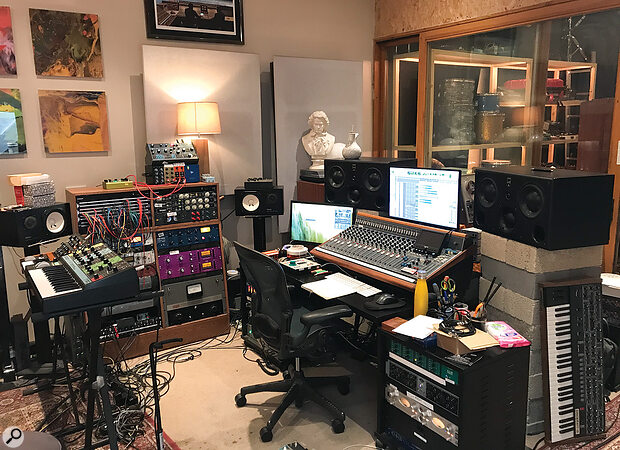 Narcissus is based around a 16-channel Neve mixer. Jarvis' studio vocals were recorded using Noel Gallagher's Neumann U47 and one of the console's 54154 preamps, which then went through one of the Distressors in the rack on the left.
Narcissus is based around a 16-channel Neve mixer. Jarvis' studio vocals were recorded using Noel Gallagher's Neumann U47 and one of the console's 54154 preamps, which then went through one of the Distressors in the rack on the left.
For the tracking stage, JARV IS... booked Jarvis Cocker's friend (and Peaky Blinders composer) Antony Genn's studio, Narcissus, in Neasden, north west London. The facility is built around a 16-channel Neve desk and eight further channels of Neve 1064s. The first task before any further recording was done, however, was for Narcissus in-house engineer Drew Dungate-Smith to sit with Cocker and the others and work out what should be kept or replaced from the live recordings.
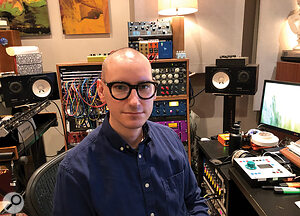 Drew Dungate-Smith engineered the recording of Beyond The Pale at Narcissus studios, where he is also the in-house engineer."Basically, when they came in, Jarvis would give me a bunch of stems," says Dungate-Smith. "'Sometimes I Am Pharaoh' had some live drums from the live performances, and on a few other tracks we just started from scratch again. The live tracks had some spill from violins and that sort of thing that acted as a glue in the background.
Drew Dungate-Smith engineered the recording of Beyond The Pale at Narcissus studios, where he is also the in-house engineer."Basically, when they came in, Jarvis would give me a bunch of stems," says Dungate-Smith. "'Sometimes I Am Pharaoh' had some live drums from the live performances, and on a few other tracks we just started from scratch again. The live tracks had some spill from violins and that sort of thing that acted as a glue in the background.
"From my point of view," he adds, "it was kind of a similar way of starting any session really. Sometimes you're given some sort of demo stems and you try and beat what's on the demo. The demo in this case just happened to be a live recording."
Dungate-Smith insists that there weren't any particular challenges in dealing with live recordings for a studio album, in terms of cleaning up unwanted bleed or crowd noise. "No, the stems were pretty clean actually," he says. "It was very close-miked and then we sort of just trimmed out anything that wasn't necessary. It was pretty easy to clean them up."
In other instances, Cocker points out, as on closing track 'Children Of The Echo', some crowd noise was kept in for moments of live spontaneity. "That was recorded at the Primavera festival in Barcelona," he says. "There's a bit where I say, 'Hello', and then the audience really loudly sang back, 'Hello!' I liked that, so we kept that, but we put a bit of echo on it, so it sounds more like a synthesizer effect than people."
Effectively, Dungate-Smith was recording JARV IS... as if they were on stage. "We'd get a live band setup going," he says, "and we didn't have much time to work on the sounds. It was more just getting a natural, honest sound of what's going on in the room. We weren't sort of spending two days tuning toms."
Drum miking was fairly standard, except for a mono overhead, which was an Electro-Voice 635A fed through one of the studio's CLM Dynamics DB400 preamps. "I've only ever seen them in this studio," says Dungate-Smith. "They have a built-in limiter and they crunch drums up quite nicely. "There's a drum booth that I set up in the middle of the room. I'd put Serafina's amp [for synths and electric harp] and Emma's amp [for violin/guitar] on either side of the drum baffles, to try and get some isolation. Everyone has at least one pedal in their chain, just to give it a little bit of a wonkiness.
"Emma has her violin going through a Fender Bronco, which is quite a cool little amp. It can get quite harsh coming out of a chunkier amp, so that little speaker helps quite a bit. Jarvis would often play guitar, but the amp would just be in the room. The only thing we wouldn't really track at the same time would be vocals. Just to give us some control and avoid cymbals."
Having been introduced to them by Scott Walker, Cocker tends to favour a Neumann U47, if one is available, for his vocals. "In Narcissus there was this great old Neumann mic," he says, "and I always sang through that. Then one week we went and it had gone. It turned out that it belonged to Noel Gallagher and for some reason it had ended up in that studio. It'd been used as a bass drum mic by Oasis, which was a complete waste of a legendary microphone."
"We gave that back to Noel and we started using one of the Flea 47s," says Dungate-Smith. "Instantly, Jarvis was sort of on the back foot with it. So, we got Noel's 47 back in and did a little A/B and it was basically identical."
"I don't know whether it was psychological or whatever," laughs Cocker. "But I thought [the Flea 47] wasn't as good as the other one. So, Noel very kindly lent it us again, so that I could finish the vocals off using it."
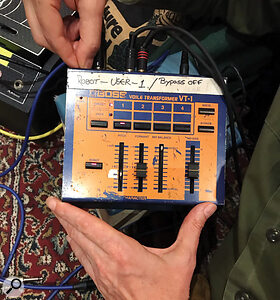 Dungate-Smith's Boss VT-1 Voice Transformer makes an appearance on 'Sometimes I Am Pharaoh'.In keeping with the live spirit of the songs' creation, Cocker was very much performing while laying down his vocal takes. "He's quite dynamic when he sings," says Dungate-Smith, "and he only really does four or five takes. So, you've kind of got to be ready. The first time you hit record, it has to be perfect.
Dungate-Smith's Boss VT-1 Voice Transformer makes an appearance on 'Sometimes I Am Pharaoh'.In keeping with the live spirit of the songs' creation, Cocker was very much performing while laying down his vocal takes. "He's quite dynamic when he sings," says Dungate-Smith, "and he only really does four or five takes. So, you've kind of got to be ready. The first time you hit record, it has to be perfect.
"I had a little bit of gain on our Neve desk preamp, which is a 34154. That was going into a Distressor which normally for him I just set up as 5-5-5-5 on every knob and went from there and did little tweaks. Just to give it a little bit of a tickle before it hit the box. Normally 4:1, high-pass filtering on the detector. He can get very loud very quickly, so it's best to play it safe and then sort of flatten it out a bit later if we need to."
In terms of standout vocal effects, 'Sometimes I Am Pharaoh' features Cocker's voice mangled by a Boss VT‑1 Voice Transformer. Elsewhere, the natural echo on Serafina Steer and Emma Smith's counter-vocals on album opener 'Save The Whale' (the only song never played live ahead of recording) was a result of pragmatic necessity.
"I don't know why we had to do this," says Cocker, "but we recorded them in the downstairs bathroom of my house in east London. The bathroom had just been decorated so there was nothing in it and it had quite an interesting echo in it [laughs]. It was quite a strange situation because Serafina was about eight-and-a-half months pregnant at the time and she was in the shower stall on a stool. It was a very ad hoc recording process, but it kind of worked."
The Mix
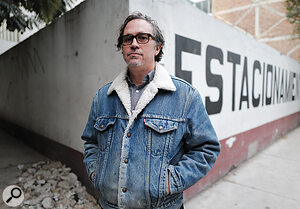 For Beyond The Pale, Craig Silvey took on mixing duties.After having heard the rough WAVs of 'Must I Evolve?' and confirmed to Jarvis Cocker that it would be possible to work from live recordings, Craig Silvey (Arcade Fire, the Rolling Stones) was brought in to mix all of the tracks on Beyond The Pale.
For Beyond The Pale, Craig Silvey took on mixing duties.After having heard the rough WAVs of 'Must I Evolve?' and confirmed to Jarvis Cocker that it would be possible to work from live recordings, Craig Silvey (Arcade Fire, the Rolling Stones) was brought in to mix all of the tracks on Beyond The Pale.
California-born Silvey's west London studio, Toast, features a 1972-built Neve 8026 console that he had shipped over from his studio's previous location in San Francisco. As with all of his projects, Silvey's first task was to split out the stems across its 40 channels.
"It's just got a sound, especially for its summing," he says of the Neve. "It's like a harmonic thing. I'll sit there with the drums at the very beginning and sort of figure out how hard I wanna hit the desk and use the kind of sponginess of the transformers on the line inputs. If you go from the just in-the-box summing and then you split it out across the 40 channels and put it all at zero, it just all instantly sounds more open and wide. Half the job is done before I even really start."
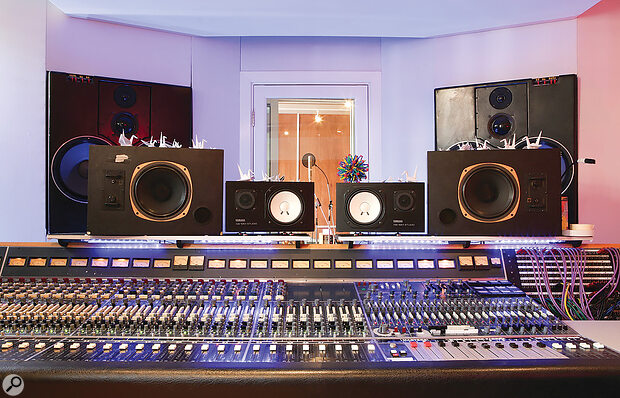 The album was mixed through the 40-channel Neve 8026 console at Toast Studios in west London.Photo: Lucy Williams (lucywilliamsphotography dotcom)
The album was mixed through the 40-channel Neve 8026 console at Toast Studios in west London.Photo: Lucy Williams (lucywilliamsphotography dotcom)
For monitors, Silvey has a pair of Boxer T2s, but mainly uses his trusty Manley Tannoy ML10s. Continuing the work of Drew Dungate-Smith, he set to further cleaning up the live elements of the tracks. "I'd mixed a couple of those kinds of live recordings before," says Silvey. "There was an Arcade Fire Reflektor live movie and that was kind of the same thing where you had to sort of save the recordings. So, I was able to apply the same techniques, which is just basically you have to go and obsessively mute everything when it's not happening.
"Then it starts to kinda clean up," he adds. "It was great 'cause you could still hear a little bit of the audience in the drum mics. And if I approached it that it was supposed to be a bit wild and a bit crazy, then it worked fine."
Silvey's go-to plug‑in effects include Altiverb (particularly his IR sample of Geoff Barrow's Great British Spring reverb), Valhalla Shimmer, Eventide's Blackhole and XLN Audio's RC-20 Retro Color. "That's a must," Silvey says of the latter. "They've got a cassette with dead batteries. I like UAD's Ampex ATR-102 for the tape sound but I also love the wow and flutter on it. They're great when you want to wobble something as a modulation effect. It's nice if you really want something to sound like it's coming off an 8mm film."
The mix process for Beyond The Pale was unusual in the sense that each session would start with Cocker coming into the studio to explain to Silvey the concept behind the track to be mixed that day. "It would usually take about an hour of him telling me the story behind the story of the song," says Silvey. "It was so great. I wish everybody would do this for me, 'cause it affected how I went about the whole thing. So, for me it was really important for his vocals and his lyrics to be really heard."
Particularly with the tragi-comic, dubby ballad 'Swanky Modes' — a tale of druggy love in Camden in the '90s — Silvey wanted to maintain the intimacy of Cocker's vocal. "I was thinking, 'This vocal's got to be dead centre, right in your face.' It's kind of like Bill Callahan from Smog, where he's telling the story and then the music is this swirly mass around it. And there's cues of the music that come off of the vocal that are kind of important. It's almost a little bit like musical theatre. That was the idea, that the anchor was the vocal and everything else was supposed to dance around it."
Most of Cocker's vocals that are dry-sounding typically still feature a touch of early reflection from an Ursa Major Space Station SST-282 digital reverb. "At points there's a bit of slap, which is usually a trusty old [Roland] Chorus Echo," says Silvey. "Or else we used a Space Case. This guy in New York takes portable Marantz tape decks from the '90s and turns them into tape echoes using a cassette. Maybe a bit of echo chamber reverb would fly off that when the sections needed to get big and open up. But in that storytelling mode, the idea was to keep it raw."
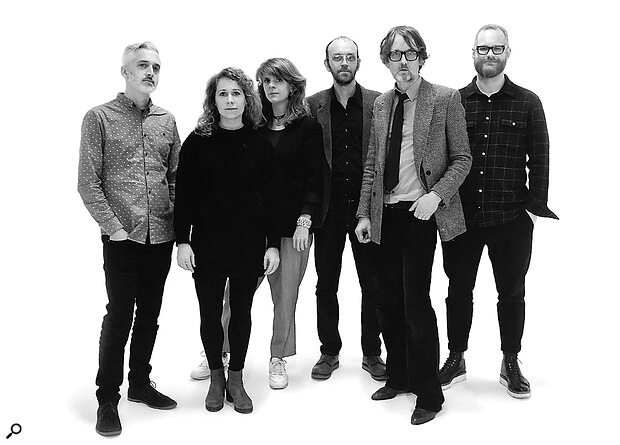 JARV IS... from left: Andrew McKinney (bass), Emma Smith (violin), Serafina Steer (harp), Jason Buckle (keyboards), Jarvis Cocker (vocals) and Adam Betts (drums).
JARV IS... from left: Andrew McKinney (bass), Emma Smith (violin), Serafina Steer (harp), Jason Buckle (keyboards), Jarvis Cocker (vocals) and Adam Betts (drums).
From Jason Buckle's perspective, the toughest track to nail in the mix process was 'Am I Missing Something?', which builds over nearly seven minutes from an electro pulse to a full-blown orchestral crescendo.
"We'd been working on that for, like, five years," says Buckle. "It'd gone through many a change. But the basic thing was still there. It was me trying to sound like DAF, the German band. Then Jarvis took it away and worked on it with Steve Mackey from Pulp, for the end bit where it all goes orchestral.
"But that one was really tricky. Just getting the right blend of the electronic and real drums was hard, and not letting it go into a mush at the end. Cause there's lots of things going off there. But it sounds good now."
Jarvis Cocker: "I've been making music for a long time, so to find a different way of working after all that time is really exciting.
Natural State
As live music remains on hold, the stage performance edges of Beyond The Pale now sound like a welcome reminder of a not-too-distant past. "Having discovered a slightly hybrid form of recording," says Cocker, "I'm hoping that we can carry on with that. I've been making music for a long time, so to find a different way of working after all that time is really exciting.
"But then that's the ironic thing, in't it?" he laughs. "Nobody knows when shows are gonna start again. We can't carry on. But that's another thing that's made me happy that we discovered it. We took advantage of it whilst it was available. Now it isn't available and nobody knows when it'll be back.
"I guess it's kind of an upside of modern technology," Cocker concludes. "Often people are talking about how technology has taken us into a dystopian future and stuff. But this record couldn't have been made without modern technology. And yet it's captured something fairly real. It's captured a song in its kind of natural state, like you've got it in the wild somehow."
